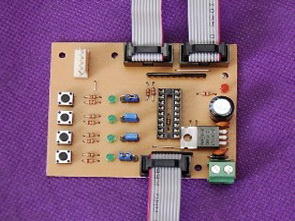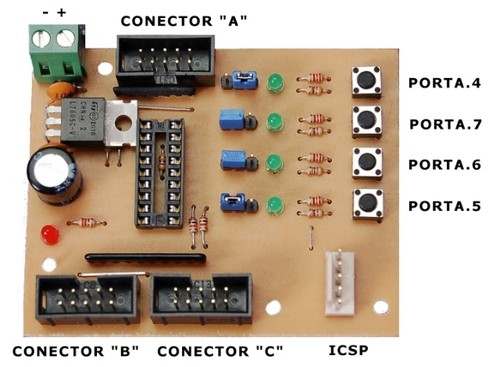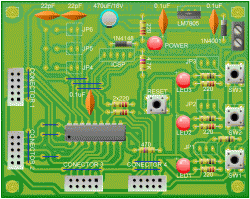
18 pin PIC16F628 PIC16F628A PIC16F84 PIC16F84A PIC16F648 Simple handy test development boards for PIC16F648A series PICs These modules have common features to be compatible with each other. Microcontroller and voltage regulator, crystal etc. They consist of a central board that is intended to house several accessory components, such as . path. It would be ideal to have a core board for each model as there are 8, 18, 28 and 40 pin PICs.
Due to space, we will develop one for the 40-pin PICs and a slightly different one for the 18-pin ones, leaving the development of the other two to the discretion of the reader, it will be an easy task if you wish. Based on the two published.
The connectors of the central plates will be used, as we said, to connect it to the modules. In order for them to be completely interchangeable, we must respect the order of the signals in the connector in all of them.
For practical reasons to make PCBs easier, each connector will use only six of the ten available wires, as seen in the figures illustrating the article. This way we will have a 5V pin on each connector, one for ground, four for data, so we have half a PIC port posted on each connector.
To avoid having to remove the microcontroller to reprogram, we will include a connector known as ICSP (In Circuit Serial Programming) on the central boards, which allows programming the PIC via a simple cable connected to our programmer.
Microchip PIC development boards


18 pin board
The first board of our module set will be the “heart” of 18-pin microcontrollers, and that is the reason for this project. It will be used to test the most common microcontrollers, including the 16F628, 16F628A, 16F648, 16F648A, 16F818A series and very long ones.
Newer 18-pin microcontrollers have the option to work with an internal oscillator, which makes the use of an external crystal and capacitor unnecessary. For this reason, we have not included them in this plate, whose photos describe the article. If for some reason we want to use an older microcontroller (like 16F84A) that requires these components, we can easily make an external module containing them and plug it into the corresponding connector.
The card in question has three expansion connectors with data pins as follows:
Connector A: PORTA.0, PORTA.1, PORTA.2, PORTA.3, +5V and ground.
Connector B: PORTB.0, PORTB.1, PORTB.2, PORTB.3, +5V and ground.
Connector C: PORTB.4, PORTB.5, PORTB.6, PORTB.7, +5V and ground.
The flat cables that will connect this board to the expansion modules will be connected to them.
There is a terminal block attached to the “A” connector and to it we need to connect the power supply, making sure that the positive and negative are in the correct position according to the silkscreen in the photo above. If we reverse the source, the diode behind the terminal will protect the integrity of the board, but of course the circuit will not work.
The board has its own 5 volt voltage regulator, an LM7805 with the necessary capacitors for its operation, so the power supply voltage should be between 7.5 and 24 volts. The maximum current that the voltage regulator can draw is 1 Amper. A red LED visually indicates if the board is live.
As the reader may have noticed, an 18-pin PIC has a maximum of 16 I/O pins, but the three expansion headers provide connections to only 12 of them. This is because it contains four buttons and four leds connected to 4 PORTA pins (4, 5, 6 and 7) on the same board, so the reader can start using this board without having to install any additional modules.
Each button shares a pin with a led and a jumper (J1 – J4)
18-Pin Microchip PIC Experiment Boards PCB schematic alternative links
Şifre-Pass: 320volt.com
Published: 2008/11/23 Tags: pic development board
PIC16F628A Example RF Transceiver Circuit with PIC-C
Example RF Transceiver Circuit PIC16F628 with C Language “Project Source isis proteus simulation and receiver, transmitter
RF Transceiver Circuit